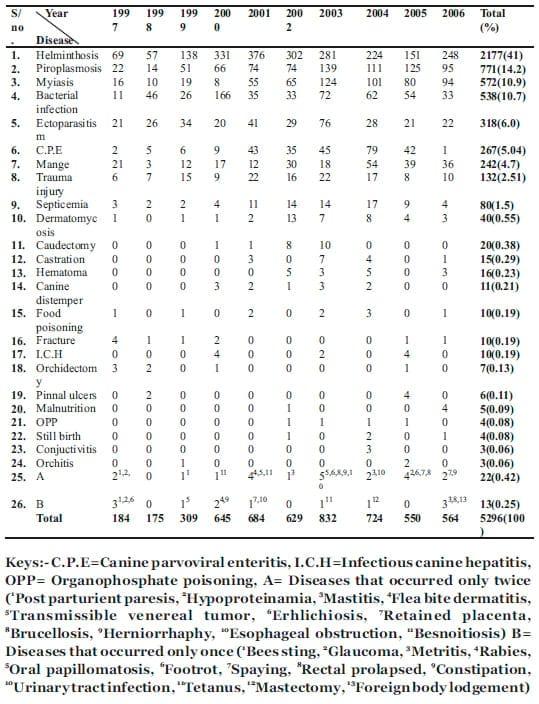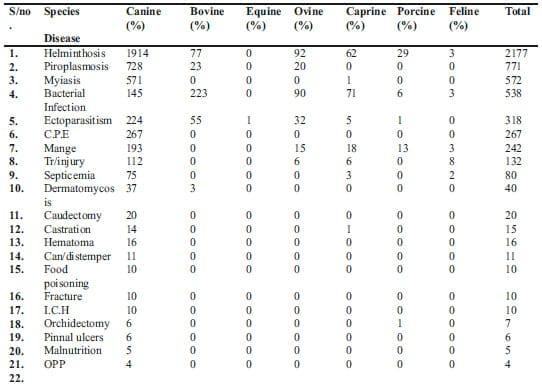A Retrospective Study of Common Diseases of Animals in a Private Clinic in Kaduna Metropolitan
Published: June 25, 2013
By: J.I. Barde, Dr. Garba Ahmed, L. Konzing, A.H. Owada (1); M.M. Gashua (2); M.N. Mohammed (3); A. Aliyu (4); I. Sa'Adatu (5); S.J. Awulu (6); and V.T. Gugong
1-Diagnostic and Extension Dept., National Veterinary Research Institute, Vom
2-Dept. of Animal Health & Production, College of Agriculture, Gujba - Yobe State
3-Dept. Animal Prod., Sch. Of Agric & Agric Technology, Fed. Univ. of Technology, Minna
4-Ministry of Agriculture and Natural Resources, Zonal Veterinary Clinic, Zuru, Kebbi State
5-Dept. of Capacity Strengthening, Regulation & Standardizations, Agricultural Research Council of Nigeria, Abuja
6-Livestock Investigation Dept., National Veterinary Research Institute, Vom
7-Dept. of General Agriculture, Nuhu Bamalli Polytechnic, Zaria- Kaduna State
2-Dept. of Animal Health & Production, College of Agriculture, Gujba - Yobe State
3-Dept. Animal Prod., Sch. Of Agric & Agric Technology, Fed. Univ. of Technology, Minna
4-Ministry of Agriculture and Natural Resources, Zonal Veterinary Clinic, Zuru, Kebbi State
5-Dept. of Capacity Strengthening, Regulation & Standardizations, Agricultural Research Council of Nigeria, Abuja
6-Livestock Investigation Dept., National Veterinary Research Institute, Vom
7-Dept. of General Agriculture, Nuhu Bamalli Polytechnic, Zaria- Kaduna State
ABSTRACT
Data from clinical records of ECWA Veterinary Clinic, Kaduna, were retrieved for diseases of livestock retrospectively over a period of 10 years (January 1997 – December 2006). The data was analyzed using descriptive statistics. The results indicate that a total of 5296 cases were handled during the 10 year study period and 48 different disease conditions were diagnosed and treated. Of the 48 disorders, Helminthosis appeared to be the most common disease condition with 2177(41%) of all cases handled, followed by Piroplasmosis 771(14.2%), Myiasis 572(10.9%), Bacterial infections 538(10.7%), Ectoparasitism 318(6%), Canine parvoviral enteritis 267(5.04%), Mange 242(4.7%), Traumatic injury 132 (2.51%), Septicemia 80 (1.5%) and Dermatomycosis 40 (0.55%). Other conditions handled included Caudectomy 20(0.38%), hematoma 16 (0.30%), castration 15 (0.28%), canine distemper 11 (0.21%), food poisoning, fracture, infectious canine hepatitis presenting 10 (0.19%) each. Others include Orchidectomy 7 (0.13%), pinnal ulcers 6 (0.11%), malnutrition 5(0.09%), organophosphate poisoning and still were handled 4 (0.08%) times each, while Conjuctivitis and Orchitis were handled only 3 (0.06%) times each. There are other 11 diseases grouped as A which appeared only twice each throughout the study totaling 22(0.42%) and other 13 diseases grouped as B appeared only once each totaling 13(0.25%). Canine species were the most presented of all animal species with 4413 (83.3%), followed by bovine 383(7.23%), ovine 260(4.9%), caprine 170(3.2%), porcine 50(0.94%), feline 19(0.35%) and equine 1(0.02%). Lack of routine de-worming and location of the clinic is responsible for this outcome. The findings elucidate the relevance of private veterinary clinics in disease reporting.
Keywords: Common diseases of livestock, Helminthosis, Piroplasmosis, ECWA Veterinary clinic, Kaduna State
INTRODUCTION
Disease recording, investigation and reporting is fundamental and key in the control of poultry and other livestock diseases world over. Nigeria is endowed with abundant livestock resources having over 13.5million heads of cattle, 22.1 million sheeps, 34.5 million goats and over 72.8 million poultry (RIM, 1992). In Nigeria, over one hundred and eleven diseases have been classified into lists A-E in order of prompt reporting requirement (Abdulkadir, 1989). List A included Rinderpest, Contagious Bovine Pleuro Pneumonia (CBPP), Foot and Mouth Disease (FMD), Newcastle Disease (ND) and Rabi e s (Abdulkadir , 1989). Subsequently, Africa Swine Fever (ASF), Bovine Spongio-encephalitis (BSE) or Mad Cow Disease and Avian Influenza or Bird Flu, were added into list A. The occurrence of these diseases in list A is expected to be reported immediately to the higher authorities as soon as possible in order to curb the spread of the diseases (Abdulkadir, 1989). In a similar way, diseases in lists B to E should also be reported promptly to higher authorities but the urgency is not required as in list Adiseases (Abdulkadir,1989). Consequently, various reports of outbreak of diseases of livestock have been documented across the country by some researchers (Williams et al, 2000; Ebbo et al, 2003; Yohanna et al, 2008; Garba et al, 2011). Despite these reports, there is paucity of report from private veterinary clinics particularly in Kaduna state. This study reports the common diseases of livestock with species distribution from a private veterinary clinic in Kaduna state.
MATERIALS AND METHODS
ECWA Veterinary Clinic is a private clinic located on No. 8A Ali Akilu Road in Northern Kaduna city. Defense Industrial Corporation Kaduna is close to the clinic. It has a work force comprising of 2 Veterinarians, 4 paravets, 4 attendants, 4 salesmen, and 2 security men during the reporting period. The clinic has a laboratory, a postmortem room, treatment room, surgery room, 3 quarantine pens, drugs & feed stores and 3 offices. The records of livestock diseases as presented to and diagnosed at the ECWA Veterinary Clinic, Kaduna during a 10-year (January1997 and December 2006) period was retrieved and analyzed retrospectively. The diagnosis at the clinic was based on clinical and post mortem findings. Descriptive statistics was used to analyze data, tables were used and proportions in percentages.
RESULTS
Table I shows diseases of livestock in Kaduna State diagnosed and treated at ECWA Veterinary Clinic Kaduna (January, 1997-December, 2006).The table depicted that a total of 5296 cases were presented and handled during the 10 year study period and 48 different disease conditions were diagnosed and treated. Of the 48 disorders, Helminthosis appeared to be the most common disease condition with 2177(41%) of all cases handled, followed by Piroplasmosis 771(14.2%), Myiasis 572( 10.9%), Bacterial infections 538(10.7%), Ectoparasitism 318(6%), Canine parvoviral enteritis 267(5.04%), Mange 242(4.7%), Traumatic injury 132(2.51%), Septicemia 80(1.5%) and Dermatomycosis 40(0.55%). Other conditions handled included Caudectomy 20(0.38%), hematoma 16(0.30%), castration 15(0.28%), canine distemper 11(0.21%), food poisoning, fracture, infectious canine hepatitis presenting 10 ( 0 . 1 9%) each. Others include Orchidectomy 7(0.13%), pinnal ulcers 6(0.11%), malnutrition 5(0.09%) , organophosphate poisoning and still were handled 4 (0.08%) times each, while Conjuctivitis and Orchitis were handled only 3(0.06%) times each. There are other 11 diseases grouped as A in the table (based on frequency of occurence) which appeared only twice each throughout the study totaling 22(0.42%) and other 13 diseases grouped as B appeared only once each totaling 13(0.25%) (Table I).
Table II which shows species distribution of cases as diagnosed and treated at the ECWA Veterinary Clinic Kaduna (January 1997 – December 2006), suggested that canine species were the most presented of all animal species with 4413 (83.3%), followed by bovine 383(7.23%), ovine 260(4.9%), caprine 170(3.2%), porcine 50(0.94%), feline 19(0.35%) with the least infection seen in the equine species 1(0.02%) (Table II). Consequently all the diseases are more seen in the canine species except for bacterial infections which were higher in the bovine species (Table II).
DISCUSSION
In this report of animal diseases in Kaduna, helminthosis presents itself as the most prevalent of animal diseases with 41% of all cases diagnosed (Table I). This is not a surprise because farmers and people hardly purchase animals or dogs and see to their deworming needs at the initial point. In addition most animals or pets are allowed to roam freely to eat garbage to see to their subsistence. This further exposes these animals to worm infestation and infections particularly, dogs, cattle, sheep, goats and swine as seen in the result (Table II). We have seen that almost all species of animals were presented to the clinic. However, of the 5296 cases handled, over 83% were in canine species (Table II). The probable reason could be that the private clinic being located in the Kaduna metropolis is bound to receive patronage from the guard dog owners (who may probably pay higher amount for the services rendered them). This is however, contrary to the report from Birnin Kebbi (which is less complex city and more of sedentary farmers than Kaduna) where more of ovine species (48.8%) and caprine species (22.4%) were presented to the only government owned veterinary clinic (Garba et al, 2011). It should be noted that virtually all members of lists A to E groups of diseases in Nigeria are represented in this study. This prevalence of various disorders in Kaduna metropolitan which were reported by other workers in the state (Fatihu et al, 2002; Okolocha et al,2007) and in other parts of the country (Cadmus et al, 1999; Ebbo et al, 2003; Salihu et al, 2005, Paul-Abiade et al, 2006; Olabode et al, 2008 and Garba et al, 2009) is a pointer to the government at all levels for the need to intensify their surveillance and diagnostic machineries for prompt tracking of any animal disease in the country. This further revealed to the government and other policy makers the relevance of enforcing policies, directing all private veterinary clinics to document and report animal diseases handled in their respective clinics to the higher and relevant authorities. It should also be noted that the patronage or cases handled in 1997 (184 cases) and 1998 (175 cases) are lowest compared to and increasing subsequently over the years with the peak in year 2003 (832 cases). The most probable reason is the public awareness level of the existence of the clinic which was established in 1997, with the peak awareness and patronage in year 2003 hence the discrepancy in the cases handled. It started declining to 724 cases in 2004, 550 cases in 2005 and 564 cases in 2006; this may not be unconnected with the religious unrest in the state over these recent years.
It is the recommendation of this paper that government should enforce the laws directing all private veterinary clinics to document and report cases diagnose/handled in their clinics to state veterinary departments for onward reports to federal authorities. It is also recommended that farmers and pet owners be educated to employ the habit of routine deworming of their animals as soon as being purchased to their farm or houses.
ACKNOWLEDGEMENT
The authors are grateful to the management of ECWA Veterinary clinic, Kaduna for giving us their record, also grateful to Prof. J.U Umoh of Ahmadu Bello University, Zaria for initiating & facilitating the research.
Table I: Diseases of livestock in Kaduna State diagnosed and treated at ECWA Veterinary Clinic Kaduna (January, 1997-December, 2006)

Table II: Species distribution of cases as diagnosed and treated at the ECWA Veterinary Clinic Kaduna (January 1997 – December 2006)

Authors:
Join to be able to comment.
Once you join Engormix, you will be able to participate in all content and forums.
* Required information
Would you like to discuss another topic? Create a new post to engage with experts in the community.
Create a post



